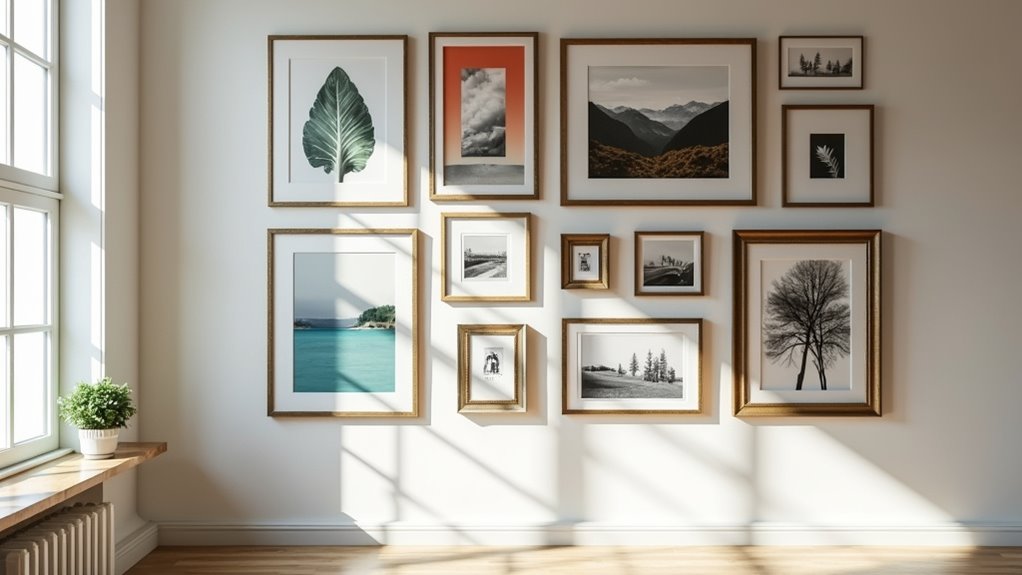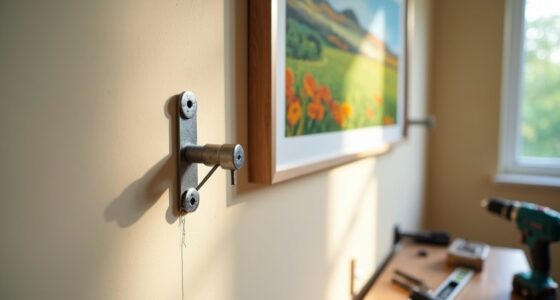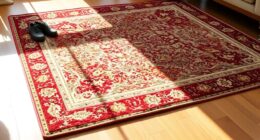Creating a gallery wall is a fun way to showcase your personality and style. Start by arranging frames on the floor to find the perfect balance. Use a unifying color palette and mix different sizes for visual interest. Keep spacing around three inches between pieces for a clean look. Hang artwork at eye level, about five feet from the floor, and consider using sustainable materials. There’s so much more to explore to make your gallery wall shine!
Key Takeaways
- Start with a large central piece to establish visual interest, then arrange smaller pieces around it for balance and cohesion.
- Maintain consistent spacing of about three inches between frames to prevent a cluttered appearance and enhance visual flow.
- Use paper templates or masking tape on the wall to plan and adjust your layout before hanging any artwork.
- Incorporate a unifying color palette and mix frame styles for a dynamic yet cohesive gallery wall that reflects personal taste.
- Ensure artwork is hung at eye level, approximately 57 inches from the floor, for optimal viewing and aesthetic appeal.
Understanding Gallery Walls
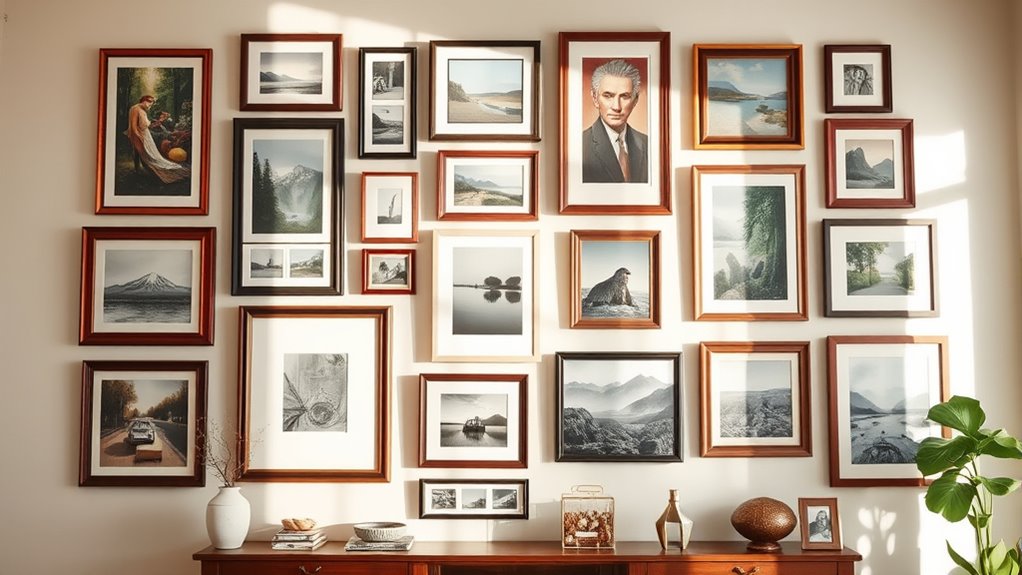
When you think about adding personality to your space, a gallery wall can be a great choice. This curated collection of art pieces—framed prints, photos, and memorabilia—enhances any wall space, making it visually interesting. Gallery walls can fit various decor styles, from casual to modern, and they work well in living rooms, dining areas, and even bathrooms. You can hang a gallery wall in different sizes and arrangements, allowing for a unique layout that reflects your personal tastes. To achieve a cohesive look, consider integrating a unifying color palette that ties the pieces together. This creative design element not only showcases your favorite art but also adds depth and dimension to your home. Additionally, incorporating natural elements can enhance the overall ambiance of your gallery wall. For a farmhouse-inspired touch, consider neutral color palettes that create a warm atmosphere and complement the artwork beautifully. A well-designed gallery wall can also benefit from vintage decor that enhances rustic charm, connecting art with the overall theme of your space. Moreover, choosing sustainable materials for your frames and art pieces can contribute to a more eco-friendly home environment.
Designing a Gallery Wall Layout
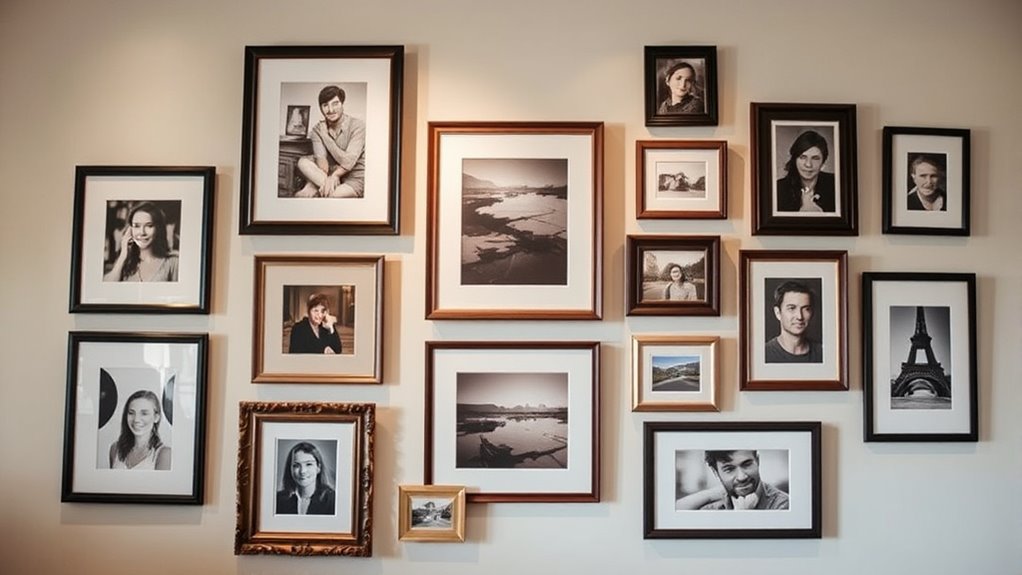
When designing your gallery wall layout, start by arranging your frames on the floor to find the best balance. Use paper templates or masking tape on the wall for easy adjustments before committing to any holes. This approach can help reduce stress levels and promote a sense of calm, aligning with the mental benefits of decluttering. Remember to keep your artwork at eye level and maintain consistent spacing for a visually appealing display. Additionally, consider incorporating durable materials that can withstand the weight of your frames for a secure installation. To enhance the overall aesthetic, think about using a cohesive color palette that complements both your artwork and the surrounding decor. Creating a gallery wall is an excellent way to transform your home into a personalized space that reflects your style and interests.
Layout Planning Techniques
Creating a stunning gallery wall starts with thoughtful layout planning, and you can achieve this by experimenting with different arrangements on the floor first.
Begin with the largest piece in the center to establish balance and visual interest. Use paper templates to represent each artwork’s size and shape, allowing you to visualize your gallery wall layout without making any permanent changes. Incorporating best lifestyle products can also enhance the overall aesthetic of your space. Consider adding unique designs to your gallery wall that reflect your personal style and creativity. Additionally, using natural materials like wood frames can complement the farmhouse aesthetic.
Maintain a spacing of about three inches between frames to guarantee coherence and avoid a cluttered look. Hang your pieces at eye level, around five feet from the floor, for maximum engagement.
Step back periodically to assess your layout from various angles and make adjustments as needed for ideal aesthetics, creating a gallery wall that truly reflects your style. Additionally, consider incorporating unique, handcrafted decor items to reflect individuality in decor.
Visual Balance Strategies
After you’ve mapped out your layout, focus on achieving visual balance in your gallery wall.
Start by placing the largest piece first to anchor your arrangement and create a focal point, ideally in an outer corner or off-center.
Experiment with spacing, maintaining about 3 inches between art pieces to avoid crowding and enhance visual balance. Additionally, consider how emotional reflections can influence the choice of art pieces to create a more personalized gallery.
Mix horizontal and vertical framed art to add visual interest and prevent a monotonous look.
Balance larger artworks with smaller ones, ensuring your overall arrangement feels cohesive and dynamic.
To refine your layout, use paper templates to map out placements on the wall, allowing for adjustments before committing to nail spots for a more accurate design. Additionally, consider incorporating aesthetic hooks to enhance both functionality and style in your gallery wall setup.
Gallery Wall Ideas for Different Spaces

Whether you’re looking to transform a blank wall or enhance an already vibrant space, gallery walls can add personality and charm to any room.
In a living room gallery, use large frames for dramatic impact, or cluster smaller frames to create a cozy storytelling vibe. Consider planning interior design to ensure the gallery complements the overall room aesthetic.
For entryways, showcase meaningful mementos or sculptures in various sizes to engage guests.
In kitchens, choose art that reflects culinary themes, keeping arrangements functional yet appealing.
Bathrooms benefit from smaller, moisture-resistant pieces hung at eye level.
In the dining room, curate a collection of art and photographs that create a warm focal point, inviting gatherings and conversations.
Mix different pieces and styles to reflect your unique taste with affordable art that resonates throughout your home. Additionally, creating a gallery wall can also serve as a form of self-care and mindfulness by allowing you to express your personality and interests in your living space.
Choosing and Mixing Artwork and Frames
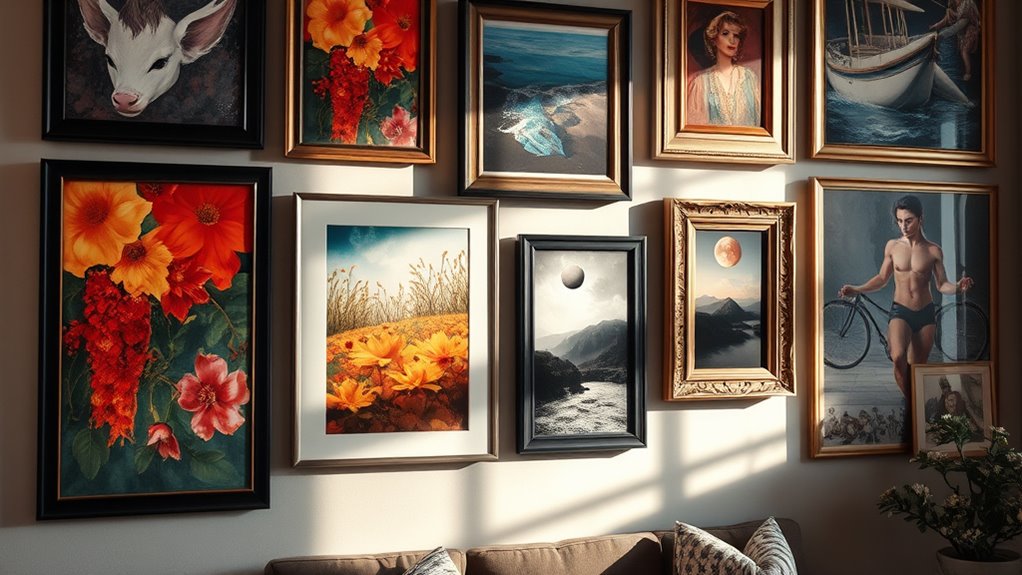
As you begin the journey of choosing and mixing artwork and frames for your gallery wall, it’s essential to strike a balance between sizes and styles. Aim to include 1-3 larger pieces alongside smaller and medium-sized artwork to create a balanced composition. Additionally, consider how innovative design ideas can inspire your choices, helping you create a unique and visually appealing arrangement.
To achieve visual cohesion, repeat colors 2-3 times across different pieces, ensuring your overall palette resonates harmoniously. Mixing various frame styles, like wood and metal, adds depth, but limit yourself to three finishes for a coherent look. Incorporating natural materials such as wood can enhance the warmth of your gallery wall while maintaining a cozy atmosphere. Furthermore, utilizing mental resilience can encourage you to experiment more boldly with your art selections and arrangements.
Don’t forget to incorporate personal items, such as family photos, to infuse individuality into your gallery wall. Using wider mats around these photos modernizes their appearance, enhancing visual unity while keeping your display dynamic and engaging. Additionally, consider how the safety features of your home environment can complement and protect your artwork from damage.
Pricing, Sustainability, and Additional Considerations
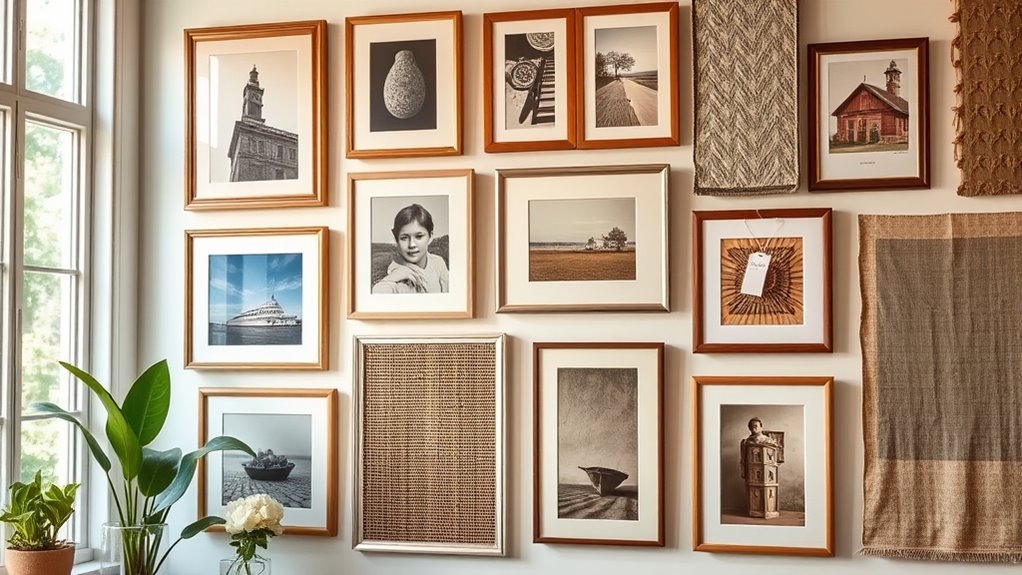
When planning your gallery wall, it’s essential to reflect on art pricing strategies that fit your budget while maintaining quality. You can also enhance your space sustainably by choosing eco-friendly materials and supporting local artists. Additionally, utilizing high-quality equipment to create art can elevate your investment value. Don’t forget to contemplate the benefits of adding mirrors; they can brighten up your room and add a unique touch to your display. Additionally, considering estate planning can help protect your investments in art and ensure they are managed according to your wishes.
Art Pricing Strategies
Establishing a budget is essential for any gallery wall project, especially since art pricing can vary widely.
Focus on building a unique art collection that resonates with you emotionally rather than just looking at price tags.
Explore diverse art options, including online shops and local markets, for affordable alternatives that fit your budget.
Consider customizing store-bought frames with mats to enhance the overall look without overspending.
Incorporating FSC® Certified art pieces guarantees responsible sourcing and aligns with sustainable practices, appealing to eco-conscious consumers.
Sustainable Material Choices
Choosing sustainable materials for your gallery wall not only helps the environment but also enhances the overall aesthetic of your space. Consider incorporating art pieces that are FSC Certified, ensuring responsible sourcing. You can also opt for frames made from recycled or upcycled materials, which reduce environmental impact and add unique character. While prices vary based on craftsmanship and materials, budgeting for non-toxic inks and eco-friendly decor will pay off in visual appeal.
| Material Type | Benefits | Considerations |
|---|---|---|
| FSC Certified Wood | Responsible sourcing | Price may vary |
| Recycled Materials | Unique character | Availability |
| Upcycled Materials | Reduces waste | Quality varies |
| Non-toxic Inks | Safe for indoor use | Limited color options |
| Eco-friendly Prints | Sustainable printing methods | Costs can be higher |
Mirror Incorporation Benefits
Incorporating mirrors into your gallery wall not only enhances the perception of space but also adds an element of sophistication. Mirrors reflect light, making your room feel larger and brighter.
With various styles, shapes, and sizes available, you can create creative combinations that complement or contrast with framed art, adding depth and dimension to your display. Plus, you’ll find budget-friendly options that fit diverse design styles, ensuring anyone can enjoy this chic addition.
Many mirrors are crafted from eco-friendly materials, aligning with sustainability goals and appealing to environmentally conscious consumers.
Wall Preparation and Hanging Techniques
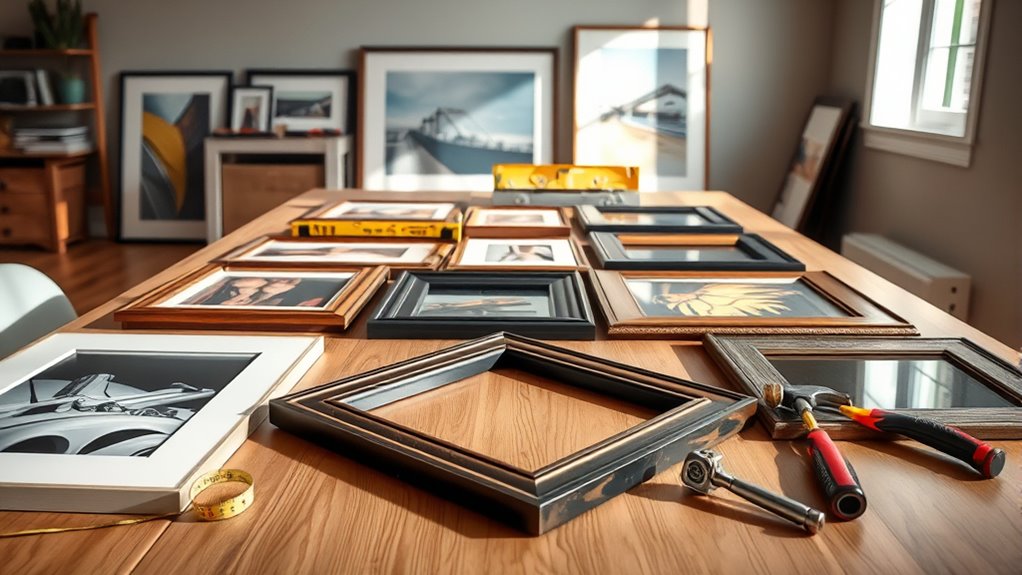
Before you plunge into hanging your artwork, it’s essential to prepare the wall for a polished finish. Start by patching, sanding, and painting to create a smooth surface. Use the 57-inch rule to position your pieces at eye level, ensuring they’re visually appealing.
Prepare your wall with care; patch, sand, and paint for a flawless backdrop before hanging your artwork at eye level.
- Use masking tape to outline your layout on the wall.
- Experiment with various arrangements using paper templates.
- Consider Command Strips for secure, damage-free hanging.
Mark your spots accurately by flipping each artwork face-down and piercing the template at the hanging points.
With thoughtful wall preparation and hanging techniques, you’ll create a stunning gallery wall that beautifully showcases your artwork while maintaining balance and negative space.
Frequently Asked Questions
How Do I Plan a Gallery Wall Layout?
To plan your gallery wall layout, start by measuring the wall space you want to use.
Use tape to outline the area on the floor or large paper for visualization.
Begin with your largest piece as the focal point, then arrange smaller pieces around it, maintaining about 3 inches of space between them.
Experiment with different layouts on the floor or with paper templates, and don’t hesitate to adjust for the best look.
What Is the Rule for Gallery Walls?
When you think of a gallery wall, imagine a beautiful tapestry of memories woven together.
The rule for gallery walls is simple: hang your artwork at eye level, about 57 inches from the floor. Keep 3 to 5 inches between frames to avoid clutter.
Start with your largest piece as an anchor, then arrange smaller ones around it. Embrace variety in frames and orientations to create a dynamic, inviting space that reflects your style.
What Is the 2/3 Rule for Wall Art?
The 2/3 rule for wall art suggests that your artwork should ideally occupy two-thirds of the wall space above your furniture.
To apply it, measure the height and width of that space, then calculate two-thirds of the height to find the perfect placement for your art’s center, typically around 57 to 60 inches from the floor.
This guideline helps guarantee your art is eye-level, enhancing visibility and creating a balanced aesthetic in your room.
How to Do a Gallery Wall for Beginners?
Did you know that a well-arranged gallery wall can increase your room’s visual appeal by up to 40%?
To get started, measure your wall and use tape to outline your desired area. Select a focal piece, then arrange smaller artworks around it, keeping about three inches apart for balance.
Stick to a cohesive color palette for unity, and consider using paper templates to plan placements before hanging. Command Strips can help avoid wall damage, too!
Conclusion
Creating a stunning gallery wall can transform your space and reflect your personality. Did you know that 74% of people feel more at home in a space that showcases personal artwork? By carefully selecting and arranging your pieces, you can enhance your environment while showcasing your unique taste. Remember to contemplate the layout, mix of styles, and proper hanging techniques to achieve a cohesive look. Now, go ahead and start curating your own gallery wall masterpiece!
